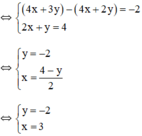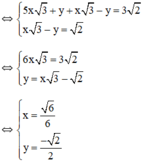Dùng phương pháp cộng đại số để giải hệ phương trình 3 x - 6 y = 9 - 2 x + 4 y = - 3
Có nhận xét về nghiệm của hệ phương trình này ?
Hãy nhập câu hỏi của bạn vào đây, nếu là tài khoản VIP, bạn sẽ được ưu tiên trả lời.

Câu a )
\(ĐKXĐx\ne-1,3\)
Ta có :
\(\frac{x}{2x+2}-\frac{2x}{x^2-2x-3}=\frac{x}{6-2x}\)
\(\Rightarrow\frac{x}{2\left(x+1\right)}-\frac{2x}{\left(x+1\right)\left(x-3\right)}=\frac{x}{-2\left(x-3\right)}\)
\(\Rightarrow\frac{x}{2\left(x+1\right)}.2\left(x+1\right)\left(x-3\right)-\frac{2x}{\left(x+1\right)\left(x-3\right)}.2\left(x+1\right)\left(x-3\right)\)
\(=-\frac{x}{2\left(x-3\right)}.2\left(x+1\right)\left(x-3\right)\)
=> x(x-3) -4x =−x(x+1)
=> \(x^2-7x=-x^2-x\)
\(\Rightarrow2x^2-6x=0\)
\(\Rightarrow2x\left(x-3\right)=0\)
\(\Rightarrow x\in\left\{3,0\right\}\)
Câu b )
Ta có :
\(\hept{\begin{cases}\sqrt{2}x-3y=2006\\2x+\sqrt{3}y=2007\end{cases}}\)
\(\Rightarrow\hept{\begin{cases}\sqrt{2}x-3y=2006\\2\sqrt{3}x+3y=2007\sqrt{3}\end{cases}}\)
\(\Rightarrow\hept{\begin{cases}\sqrt{2}x-3y=2006\\2\sqrt{3}x+3y+\sqrt{2}x-3y=2007\sqrt{3}+2006\end{cases}}\)
\(\Rightarrow\hept{\begin{cases}\sqrt{2}x-3y=2006\\\left(\sqrt{2}+2\sqrt{3}\right)x=2007\sqrt{3}+2006\end{cases}}\)
\(\Rightarrow\hept{\begin{cases}y=\frac{\sqrt{2}x-2006}{3}\\x=\frac{2007\sqrt{3}+2006}{\sqrt{2}+2\sqrt{3}}\end{cases}}\)
\(\hept{\begin{cases}y=\frac{\sqrt{2}.\frac{2007\sqrt{3}+2006}{\sqrt{2}+2\sqrt{3}}-2006}{3}\\x=\frac{2007\sqrt{3}+2006}{\sqrt{2}+2\sqrt{3}}\end{cases}}\)
\(\Rightarrow\hept{\begin{cases}y=\frac{2007\sqrt{6}-4012\sqrt{3}}{\left(\sqrt{2}+2\sqrt{3}\right).3}\\x=\frac{2007\sqrt{3}+2006}{\sqrt{2}+2\sqrt{3}}\end{cases}}\)

a) Ta có: \(\left\{{}\begin{matrix}\sqrt{2}x-y=3\\x+\sqrt{2}y=\sqrt{2}\end{matrix}\right.\)
\(\Leftrightarrow\left\{{}\begin{matrix}\sqrt{2}x-y=3\\\sqrt{2}x+2y=2\end{matrix}\right.\)
\(\Leftrightarrow\left\{{}\begin{matrix}-3y=1\\x+\sqrt{2}y=\sqrt{2}\end{matrix}\right.\Leftrightarrow\left\{{}\begin{matrix}y=-\dfrac{1}{3}\\x=\sqrt{2}-\sqrt{2}y\end{matrix}\right.\)
\(\Leftrightarrow\left\{{}\begin{matrix}y=-\dfrac{1}{3}\\x=\sqrt{2}-\sqrt{2}\cdot\dfrac{-1}{3}=\dfrac{4\sqrt{2}}{3}\end{matrix}\right.\)
Vậy: Hệ phương trình có nghiệm duy nhất là \(\left\{{}\begin{matrix}x=\dfrac{4\sqrt{2}}{3}\\y=-\dfrac{1}{3}\end{matrix}\right.\)
b) Ta có: \(\left\{{}\begin{matrix}\dfrac{x}{2}-2y=\dfrac{3}{4}\\2x+\dfrac{y}{3}=-\dfrac{1}{3}\end{matrix}\right.\)
\(\Leftrightarrow\left\{{}\begin{matrix}2x-8y=3\\2x+\dfrac{1}{3}y=-\dfrac{1}{3}\end{matrix}\right.\Leftrightarrow\left\{{}\begin{matrix}-\dfrac{25}{3}y=\dfrac{10}{3}\\2x-8y=3\end{matrix}\right.\)
\(\Leftrightarrow\left\{{}\begin{matrix}y=-\dfrac{2}{5}\\2x=3+8y=3+8\cdot\dfrac{-2}{5}=-\dfrac{1}{5}\end{matrix}\right.\)
hay \(\left\{{}\begin{matrix}x=-\dfrac{1}{10}\\y=-\dfrac{2}{5}\end{matrix}\right.\)
Vậy: Hệ phương trình có nghiệm duy nhất là \(\left\{{}\begin{matrix}x=-\dfrac{1}{10}\\y=-\dfrac{2}{5}\end{matrix}\right.\)
c) Ta có: \(\left\{{}\begin{matrix}\dfrac{2x-3y}{4}-\dfrac{x+y-1}{5}=2x-y-1\\\dfrac{x+y-1}{3}+\dfrac{4x-y-2}{4}=\dfrac{2x-y-3}{6}\end{matrix}\right.\)
\(\Leftrightarrow\left\{{}\begin{matrix}\dfrac{5\left(2x-3y\right)}{20}-\dfrac{4\left(x+y-1\right)}{20}=\dfrac{20\left(2x-y-1\right)}{20}\\\dfrac{4\left(x+y-1\right)}{12}+\dfrac{3\left(4x-y-2\right)}{12}=\dfrac{2\left(2x-y-3\right)}{12}\end{matrix}\right.\)
\(\Leftrightarrow\left\{{}\begin{matrix}10x-15y-4x-4y+4=40x-20y-20\\4x+4y-4+12x-3y-6=4x-2y-6\end{matrix}\right.\)
\(\Leftrightarrow\left\{{}\begin{matrix}6x-19y+4-40x+20y+20=0\\16x+y-10-4x+2y+6=0\end{matrix}\right.\)
\(\Leftrightarrow\left\{{}\begin{matrix}-34x+y=-24\\12x+3y=4\end{matrix}\right.\)
\(\Leftrightarrow\left\{{}\begin{matrix}-102x+3y=-72\\12x+3y=4\end{matrix}\right.\Leftrightarrow\left\{{}\begin{matrix}-114x=-76\\12x+3y=4\end{matrix}\right.\)
\(\Leftrightarrow\left\{{}\begin{matrix}x=\dfrac{2}{3}\\12\cdot\dfrac{2}{3}+3y=4\end{matrix}\right.\Leftrightarrow\left\{{}\begin{matrix}x=\dfrac{2}{3}\\3y=4-8=-4\end{matrix}\right.\)
hay \(\left\{{}\begin{matrix}x=\dfrac{2}{3}\\y=-\dfrac{4}{3}\end{matrix}\right.\)
Vậy: Hệ phương trình có nghiệm duy nhất là \(\left\{{}\begin{matrix}x=\dfrac{2}{3}\\y=-\dfrac{4}{3}\end{matrix}\right.\)

 (Nhân cả hai vế của pt 2 với 2 để hệ số của x bằng nhau)
(Nhân cả hai vế của pt 2 với 2 để hệ số của x bằng nhau)
 (Hệ số của x bằng nhau nên ta trừ từng vế của 2 pt)
(Hệ số của x bằng nhau nên ta trừ từng vế của 2 pt)

Vậy hệ phương trình có nghiệm duy nhất (3; -2).

b: \(\left\{{}\begin{matrix}3x-2y=4\\2x+y=5\end{matrix}\right.\Leftrightarrow\left\{{}\begin{matrix}3x-2y=4\\4x+2y=10\end{matrix}\right.\)
\(\Leftrightarrow\left\{{}\begin{matrix}-x=-6\\2x+y=5\end{matrix}\right.\Leftrightarrow\left\{{}\begin{matrix}x=6\\y=5-2x=5-12=-7\end{matrix}\right.\)

\(\left\{{}\begin{matrix}5x+y=4\\-5x-y=-4\end{matrix}\right.\\ \Leftrightarrow\left\{{}\begin{matrix}5x+y=4\\5x+y-5x-y=4-4\end{matrix}\right.\\ \Leftrightarrow\left\{{}\begin{matrix}5x+y=4\\0=0\left(luôn.đúng\right)\end{matrix}\right.\)
vậy hệ phương trình có vô số nghiệm
cho mình hỏi là vô số nghiệm với cả x và y đều thuộc R đúng không ạ ?

 (Chia hai vế pt 2 cho √2 để hệ số của y đối nhau)
(Chia hai vế pt 2 cho √2 để hệ số của y đối nhau)
 (Hệ số của y đối nhau nên cộng từng vế của 2 pt)
(Hệ số của y đối nhau nên cộng từng vế của 2 pt)

Vậy hệ phương trình có nghiệm duy nhất 

a) Ta có: \(\left\{{}\begin{matrix}-x+2y=3\\3x+y=-1\end{matrix}\right.\)
\(\Leftrightarrow\left\{{}\begin{matrix}-3x+6y=9\\3x+y=-1\end{matrix}\right.\Leftrightarrow\left\{{}\begin{matrix}7y=8\\-x+2y=3\end{matrix}\right.\)
\(\Leftrightarrow\left\{{}\begin{matrix}y=\dfrac{8}{7}\\-x=3-2y=3-2\cdot\dfrac{8}{7}=\dfrac{5}{7}\end{matrix}\right.\)
hay \(\left\{{}\begin{matrix}x=-\dfrac{5}{7}\\y=\dfrac{8}{7}\end{matrix}\right.\)
Vậy: Hệ phương trình có nghiệm duy nhất là \(\left\{{}\begin{matrix}x=-\dfrac{5}{7}\\y=\dfrac{8}{7}\end{matrix}\right.\)
b) Ta có: \(\left\{{}\begin{matrix}2x+2\sqrt{3}\cdot y=1\\\sqrt{3}x+2y=-5\end{matrix}\right.\)
\(\Leftrightarrow\left\{{}\begin{matrix}2\sqrt{3}x+6y=\sqrt{3}\\2\sqrt{3}x+4y=-10\end{matrix}\right.\)
\(\Leftrightarrow\left\{{}\begin{matrix}2y=\sqrt{3}+10\\\sqrt{3}x+2y=-5\end{matrix}\right.\)
\(\Leftrightarrow\left\{{}\begin{matrix}y=\dfrac{\sqrt{3}+10}{2}\\x\sqrt{3}+2\cdot\dfrac{\sqrt{3}+10}{2}=-5\end{matrix}\right.\)
\(\Leftrightarrow\left\{{}\begin{matrix}y=\dfrac{\sqrt{3}+10}{2}\\x\sqrt{3}=-5-\sqrt{3}-10=-15-\sqrt{3}\end{matrix}\right.\)
hay \(\left\{{}\begin{matrix}x=-1-5\sqrt{3}\\y=\dfrac{\sqrt{3}+10}{2}\end{matrix}\right.\)
Vậy: Hệ phương trình có nghiệm duy nhất là \(\left\{{}\begin{matrix}x=-1-5\sqrt{3}\\y=\dfrac{\sqrt{3}+10}{2}\end{matrix}\right.\)
⇒ hệ phương trình vô nghiệm do phương trình 0x + 0y = 9 vô nghiệm.
Nhận xét: Hệ phương trình trên vô nghiệm.